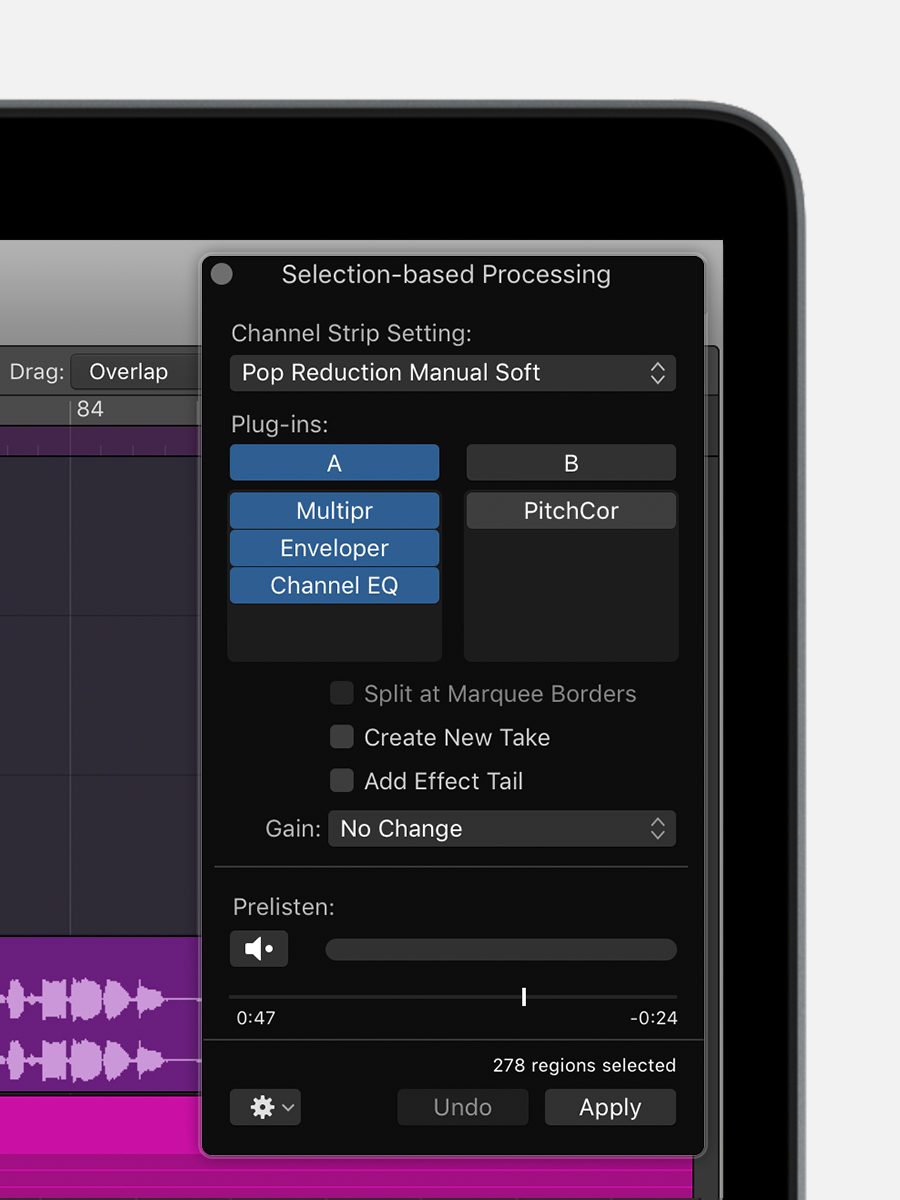

- APPLYING EFFECTS TO ONE PART OF A TRACK LOGIC PRO 8 HOW TO
- APPLYING EFFECTS TO ONE PART OF A TRACK LOGIC PRO 8 WINDOWS
I think I'll make a copy of the file onto another track and edit that one so that I've still got the original in case I don't like the edit Enjoy yourself while you can, because the Singularity is approaching.Ĭheck out my other articles, reviews, interviews and my video tutorial series, Synthesis 101 available exclusively on The Pro Audio Files.Thanks, good to know that you can't undo the processing. You are now armed with the necessary Tempo tools to create a more convincing musical simulacrum. Edit, thin or manipulate that automation data to taste. Stop the session and the automation should magically appear in your Tempo Track.ġ2. Adjust the tempo as the session plays.ġ1. You will only be using this track to receive Controller Data so it doesn’t matter.ġ0. Create a New Instrument Track with any instrument you choose or make it an External MIDI Track.

Now when you move you controller you should see the Tempo display change as well.ĩ. Here you can also set the useable range which defaults to MIDI values 0 – 127 being mapped to 50 to 177 BPM.Ĩ. Choose Control and pick a Controller Number that matches the controller number of the knob or slider on your device that you intend to use. Select the MIDI Input which defaults PitchBend.
APPLYING EFFECTS TO ONE PART OF A TRACK LOGIC PRO 8 WINDOWS
Click on the right side of the Fader object to expose the Setting Windows on the Left.ħ. Connect the object between the Sequencer Input Object and the Input View Box.Ħ. Select New/Fader/Specials/Tempo Control to create a new Tempo Fader.ĥ. Choose Clicks and Ports in the Layer Drop Down menu in the upper right.Ĥ. Go to Window/Open MIDI Environment or - yes, the dreaded Environment Window.ģ. Go to File/Project Settings/Recording and Click “Allow tempo change recording”.Ģ. So here’s the work around step by step:ġ. Likewise, automating and recording changes for the assigned parameter happens as you select Latch/Touch or Write under the Automation Mode drop-down menu and play the track.īut recording to the Tempo Track cannot be done in the same way. Simply move the parameters on screen and click to bring up the controller assignment dialog. Typically, assigning a continuous controller (CC) or a knob or slider on a MIDI controller to a parameter in Logic is fairly painless. But none of them address the idea of changing and recording tempo as the track plays. Logic Pro X/Key Commands/Edit/ or Ĭontinuous Control & Recording of Tempo ChangesĪll the Tempo adjustment techniques above have their place and are appropriate in certain circumstances. The Tap Tempo process can be used to define a beginning tempo by defining a Key trigger in the Global Key Command Menu. You can even random tempo change events based on a maximum change parameter, or thin out existing data. The change is reflected in the graphic at the bottom. Transition can be abrupt or smooth based on the density of change events as fast as a 1/32 note division. Here you can make various sorts of transitions between two tempo values in an area defined by the yellow Cycle area. The Tempo Operations box can be opened using the menu: Edit/Tempo/Tempo Operations. You can also save Tempo sets in the List view, which are basically tempo templates, using the drop-down menu (shown above). The list, however, does not reflect the transition curve of the change, only the start and end points.

When you make a change in the list you will see the change reflected in the Tempo Lane as well…and vice versa.

The simplest method is to change the tempo in the display bar by clicking and dragging or typing in the box. One obvious application for this would be to achieve a rubato effect or a free-flowing tempo as if following the fluid ebb and flow of a conductor’s baton.įirst, let’s look at the various ways to alter tempo in Logic in non-real time.
APPLYING EFFECTS TO ONE PART OF A TRACK LOGIC PRO 8 HOW TO
There are several ways to set and alter Tempo in Logic Pro, but it’s not immediately clear how to control and record tempo changes in real time by using a continuous controller.


 0 kommentar(er)
0 kommentar(er)
